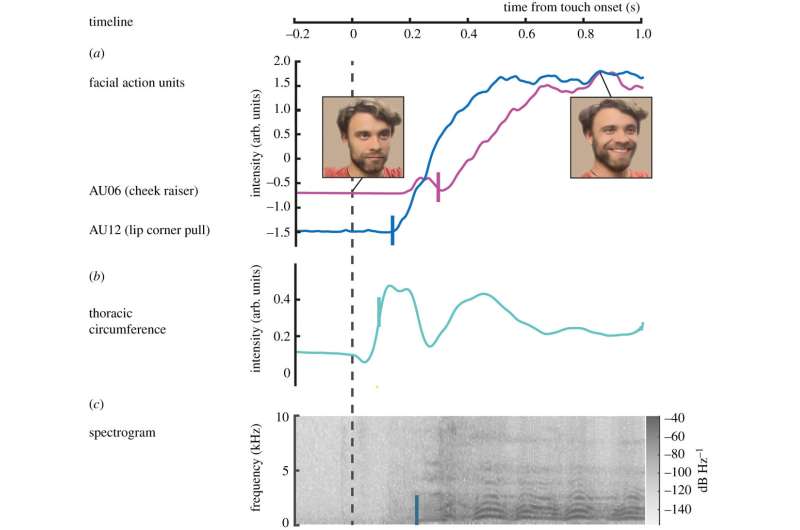Multimodal time series of a tickle response. Time series of four physiological measures, shown exemplarily for one trial after tickling of the most ticklish body part (here, armpit) of participant 1. Data in all panels are shown relative to touch onset (dashed line). (a) Facial action unit AU12 (lip corner pull, blue trace) and AU06 (cheek raiser, purple trace). Video stills show the facial expression of the participant in that trial at the time of touch onset (left) and at the peak of the response at 0.86 s after touch onset (right). (b) Thoracic circumference. (c) Spectrogram of vocalization. Response latencies (solid vertical lines) were computed using the Matlab function findchangpts to find the most significant change points in mean and slope of individual traces within 1 s time-interval post touch onset. Credit: Philosophical Transactions of the Royal Society B: Biological Sciences (2022). DOI: 10.1098/rstb.2021.0185
A team of researchers working at Humboldt-Universität in Berlin, has measured several aspects of the tickle response in humans and has developed a theory to explain why humans cannot tickle themselves. In their paper published in the journal Philosophical Transactions of the Royal Society B: Biological Sciences, the group describes studying physical reactions to tickling in several volunteers.
Tickling or being tickled holds a special place in mammalian response—it does not seem to serve a purpose. It also has proven to defy explanation. Humans are not the only creatures to experience tickling—dolphins, chimps, dogs and rats have a tickle response. In all groups, the response is nearly the same—there is a moment of perception followed by a smile and then a laugh. In this new effort, the researchers set out to learn more about tickling. To that end, they recruited 12 volunteers.
Each of the volunteers sat on a chair with their underarms and feet bared, ready for easy access by a partner who was the tickler. Prior to the tickling, the volunteers were given time to get to know one another a little bit. The researchers also filmed the action with GoPro cameras—one aimed at the face, the other the body part to be tickled.
In studying the videos, the researchers found that as expected, the first reaction to being tickled was a change in facial expression. A smile began forming at approximately 300 milliseconds, followed very closely by a change in breathing. Then, 200 milliseconds later, vocalizations began, generally in the form of a laugh. As the tickling ensued, the researchers asked the person being tickled to rate how ticklish the sensations were that they were feeling. The researchers found that, as expected, the volunteers found the feet to be the most ticklish. They also found that as ratings of ticklishness rose, so, too, did the volume of laughter.
The researchers ran the same experiment a second time, but on the second go, asked the volunteers to tickle themselves while they were being tickled by the partner. And that, the researchers found, resulted in greatly reducing the ticklishness of the tickles administered by their partner.
The researchers acknowledge that they still have no idea what goes on with the nervous system when tickling occurs, but theorize that the reason people cannot tickle themselves is that the brain sends signals inhibiting tickling when we touch ourselves—otherwise, people would be giggling when putting on socks or scratching under their arms.
More information: Sandra Proelss et al, The human tickle response and mechanisms of self-tickle suppression, Philosophical Transactions of the Royal Society B: Biological Sciences (2022). DOI: 10.1098/rstb.2021.0185
© 2022 Science X Network
























